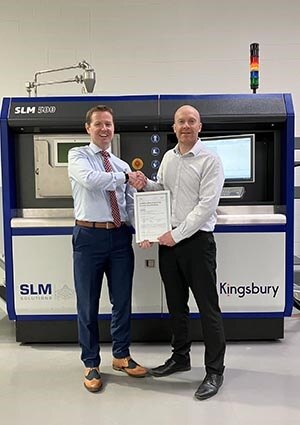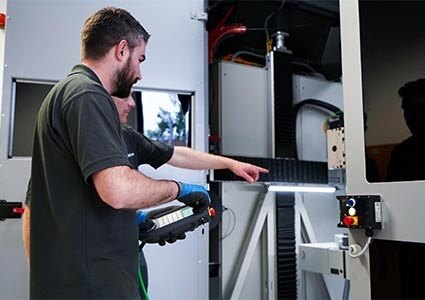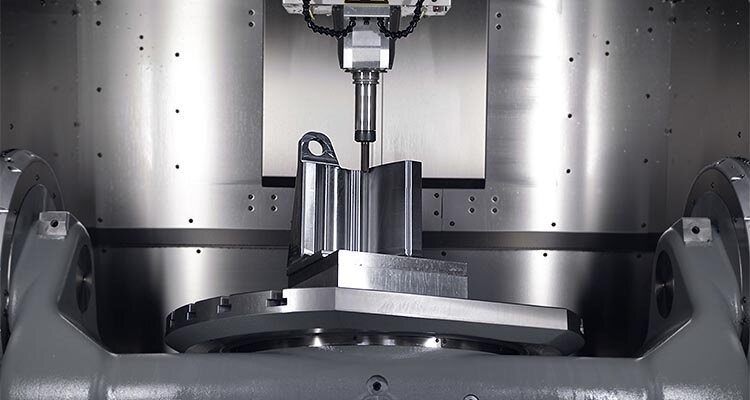How Kingsbury’s 3D printing arm, Additure, is unlocking potential and disrupting supply chains
With a vast range of applications and the potential to disrupt supply chains, 3D printing has taken the world by storm over the last 15-to-20 years. However, metal 3D printers require a high initial expenditure, meaning few companies are bringing such capabilities in house. That’s where Kingsbury Machine Tools’ (Kingsbury) new venture and trading arm, Additure, comes into play.
Having outgrown its facility just over a year after its foundation in 2022, Additure is an additive manufacturing company specializing in 3D printing. On a mission to educate others and share technologies with wider industries, the business takes a collaborative approach to helping manufacturers overcome challenges through a variety of innovative solutions. Richard Kingsbury, Managing Director of Kingsbury and Additure, and Ian Brooks, Technical Director of Additure, join us to share details of the company’s success. 
“Kingsbury has been around for nearly 70 years, acting as a distributor for German manufacturers of high-end machine tools,” Richard opens. “Traditionally, those machine tools have been in the realm of subtractive manufacturing, where a machine takes material away from the core metal to create the desired shape or product.
“Over the last 20 years, however, the world has awakened to additive manufacturing, which deposits and layers small amounts of material to create a form. Although additive is not necessarily faster than subtractive manufacturing, it has several other benefits, and we became involved with additive manufacturing through two different technologies: laser powder bed fusion (LPBF) and wire arc additive manufacturing (WAAM).
“We started off by selling machines in the UK and Middle East. Everyone we spoke to had similar responses; they loved the product and its capabilities but couldn’t afford the initial capital expense and instead asked us to machine parts for them. In the early days, we collaborated with our German partners to machine the products, but we quickly realized that establishing our own machining arm would be a more effective way of fulfilling these requests.”
Service solutions
Hence, Kingsbury’s 3D printing venture, Additure, was born. “Additure is responsible for delivering our 3D printing capabilities; not only the printing itself, but also the supply of machines to customers interested in purchasing one,” Richard explains. “We established our own printing facility and employed some exceptionally talented people, one of which being Ian, to manage and monetize this arm of the business.
“Today, people better understand the technology; it’s not just pressing a button and printing a part, but analyzing the quality control, material flow, and density of that part. Some of our customers have been on a journey with us since the early days, and while we’re seeing continued success in printing parts, some have purchased their own machine from us too.”
Ian adds: “Our operation helps businesses overcome the initial obstacles they typically come across when exploring 3D printing, like cost and material integrity. As we then identified a gap in the supply chain, primarily for large OEMs, oil and gas companies, and the defense sector, we now occupy two streams of business: contract manufacturing and pre- and post-sales support.
“We’ve experienced phenomenal success and grown rapidly, to the point that we’ve recently moved to a new, larger facility. Over time, customers started to request technical products or orders of significant magnitude that we couldn’t appropriately service from the former site. Our growth was constrained, and so we knew it was time to move on.
Expanding capabilities
“Our new site near Samlesbury, England, is 6000 square feet and open plan, enabling us to operate without limits and with room for growth. Also, while we have ISO 9001 certification through Kingsbury, we’ve received an accreditation from LRQA, which is specific to additive manufacturing sites. There are only a handful of sites in the world with this certification, but we’re the only commercial organization in the UK, working with both LPBF and WAAM, with such an award.
 “We’re already onboarding new machines to expand our capabilities,” Ian continues. “We’re on track to receive a second Gefertec machine, the arc80X, in Q1 of 2025, which will be the first machine of this type delivered to the UK. As it’s a brand-new system for Gefertec, we’re working with them to test prototypes and develop this technology ahead of its release to the wider market.”
“We’re already onboarding new machines to expand our capabilities,” Ian continues. “We’re on track to receive a second Gefertec machine, the arc80X, in Q1 of 2025, which will be the first machine of this type delivered to the UK. As it’s a brand-new system for Gefertec, we’re working with them to test prototypes and develop this technology ahead of its release to the wider market.”
Turning to the company’s impact on customers’ supply chains, Richard states: “We’ve made some bold decisions to change the way we work with customers, and in a small but distinct way, we’re disrupting the supply chain with 3D metal printing. Although Covid isn’t the only factor that’s caused concern over the last few years, it certainly had an impact on the way people view their supply chain.
“Certain industries like aerospace or oil and gas typically have parts made from a cast or forged form, but if you cast material, you have to manufacture a specific tool for that process. This is an expensive step that is justified by large order volumes; but what about the situations where only one or a few parts are required?
Rapid response
“We worked with rail giant, Deutsche Bahn (DB), for instance, to provide a component called the secondary roll stop. As this part isn’t normally subject to wear and tear, it isn’t kept in stock. However, one of the parts had been accidentally damaged and DB were challenged with a minimum order quantity of four and a ten-month lead time from their supplier.
“By using 3D printing, we could provide DB with an alternative production method. From pulling the trigger to delivering the parts, the process took five months, but most of this time was taken up with the initial development of the process. Once established, we repeated the journey and managed to produce the part within just three days, significantly reducing the supplier’s ten-month lead time.
“Another example is our work with the Saline Water Conversion Corporation (SWCC) in Saudi Arabia to digitize their warehouse. As most of Saudi Arabia’s drinking water comes from the desalination of sea water, a huge inventory of spare parts is required to ensure operations run effectively. To reduce the cash tie up of such a holding, as well as the space required, we’ve created a digital inventory of established print and machine operations that allow for a rapid response whilst eliminating work in progress.”
Competitive concept
On the topic of projects, Ian is keen to share details of Additure’s involvement with I-Break. “I-Break is a £30-million, five-year project to explore an alternative production method to reduce lead times for Airbus’ landing equipment,” he explains. “As one of 12 consortium partners, we’re looking at the manufacturing processes behind the production of landing gear as part of the objective to reduce 18-month lead times to around six or even three months.”
As our conversation draws to a close, Richard and Ian reflect on the uptake of 3D printing and the ways in which Additure can reap the rewards. Richard comments: “We’re currently involved in some interesting conversations in the Middle East; not about supplying parts or printers, but about helping to set up a version of Additure in the region to support the oil and gas industry. Nothing is set in stone, but this could add an interesting division to an already unique business.”
Ian adds: “Many people would argue that by supporting others in the ways we do, we’re building our own competitors, but we disagree. Instead, we believe that by educating the supply chain, demand will grow, and there will be enough commercial success to develop the supply chain together with others.”
“That’s right,” Richard concludes. “As people learn more about the applications and capabilities of the technology, more products and systems will be designed with 3D printing suitability in mind. Metal 3D printing is also a more sustainable production method, so as demands and regulations around sustainable manufacturing come into force, we are poised to offer a competitive solution.”
